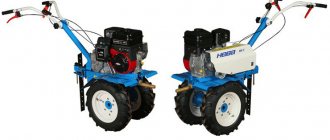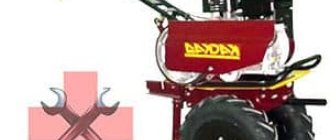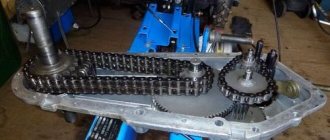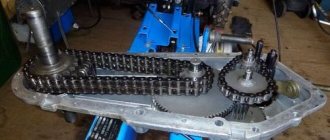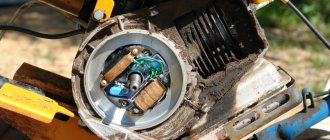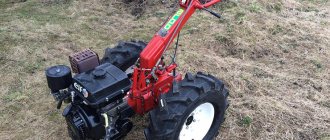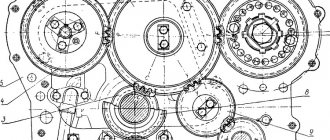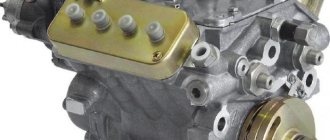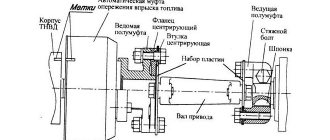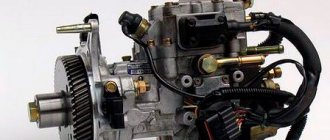Design of the ignition system on a walk-behind tractor
Today, more and more people use walk-behind tractors on their plots.
This is not surprising, because such equipment can do absolutely everything: plow the ground, plant and harvest potatoes, transport cargo, and even remove snow. However, like any other machines, walk-behind tractors sometimes break down and require repair. In this article we will look at the ignition system of a walk-behind tractor, the types of its breakdowns, how to eliminate them, as well as the process of adjusting the ignition. And if the cause of the malfunction lies precisely here, it will not be difficult for you to eliminate it.
Gearbox and signs of damage
Most often, gearbox-related breakdowns occur due to overloading of the device. Such malfunctions are characterized by bursting of bushings and breakage of the star. You should know that if a star is torn off, welding will be required to put it back in place. A typical scheme for checking the gearbox when repairing a Cascade walk-behind tractor with your own hands (or from any other company) can be found in the same manual, which describes the procedure for setting up the carburetor. The main breakdowns and ways to eliminate them are:
- Clutch slip failure. This mainly occurs due to severe wear of the discs and weakening of the compression spring, as well as when the distance between the bearing elements decreases. To eliminate damage, all worn parts are replaced.
- The clutch does not disengage completely. This problem is associated with deformation of the friction disc or incorrectly selected oil. Performance is restored by replacing the disk or changing the oil.
- Extraneous noise is heard from the gearbox. The cause of the noise is a lack of oil in the gearbox or severe deformation of the gears. The source of the sound can also be a loose bearing. Repair occurs by replacing elements with new ones.
- The speed does not change or switching occurs with great effort. The solution to the problem is to disassemble the gearbox and, if its mechanism is slightly worn, lubricate and grind the gears.
- Oil leak. First of all, the seals are checked for correct installation and general condition. They change if necessary. A leak can also form due to a blockage in the area of the oil fill hole.
- During operation, strong vibration occurs. The engine fastenings are checked and, if necessary, tightened. Vibration also occurs when additional accessories are installed incorrectly. If the walk-behind tractor uses tires, it is also worth checking the pressure level in them.
It is important to note that if, during the repair of a cultivator with a worm gear, a problem is discovered in it, and this is typical for the Texas LH model, then you will not be able to replace worn or crumbled gears yourself. Since the device does not allow changing the load force, the connection between the worm and the gear wears out significantly
Such parts are not sold separately, so the entire assembly has to be replaced
Since the device does not allow changing the load force, the junction of the worm and gear wears out significantly. Such parts are not sold separately, so the entire assembly has to be replaced.
In order to ensure that breakdowns occur as rarely as possible due to the gearbox, you should not only not overload the device, but also add oil on time. It is best to wash the gearbox elements in diesel fuel or gasoline. When assembling the gearbox, it is recommended to additionally lubricate its gasket with silicone.
Setting up the walk-behind tractor ignition system
The ignition system is a very important design that ensures the formation of a spark in the internal combustion chamber to ignite the air-fuel mixture. In order not to encounter breakdowns and not to call a repairman, you need to know how to correctly set the ignition on the walk-behind tractor. This can be done in different ways.
- Thanks to the spark. Do the following:
- Turn the crankshaft so that the pulley mark and the mark located at the base of the timing mechanism coincide. In this case, the interruption-distribution slider should point to the high-voltage wire of one of the cylinders;
- loosen the nut that positions the body of the mechanism that determines the moment of creation of high-voltage pulses;
- from the system cover, which determines the moment of creation of high-voltage pulses, you need to remove the high-voltage wire located in the center, and place its contact at a distance of 5 millimeters from the “ground” of the walk-behind tractor;
- now turn on the ignition;
- the body of the mechanism that determines the moment of creation of the above-mentioned impulses must be turned clockwise to the 200 mark;
- now slowly turn your body in the opposite direction;
- the position of the mechanism should not change, but at the same time you will see a spark between the contact located in;
- tighten the breaker nut.
- Using your hearing:
- start the engine;
- Unscrew the nut that holds the distributor base a little;
- the interrupter housing must be slowly rotated on both sides;
- the state of the mechanism, which determines the appearance of high-voltage pulses, must be fixed in the position when the motor power is the highest and the speed is the highest. Listen carefully;
- turn the breaker body clockwise;
- Now firmly fasten the distributor fastening element;
- Using a strobe:
- heat the walk-behind tractor engine to a state optimal for operation;
- connect the power supply of the strobe to the network of your unit;
- the sensor, which is designed to trigger the sound, must be placed on the high-voltage electrical wire of one of the cylinders;
- remove the vacuum correction hose and plug it;
- the light from the strobe should be directed towards the pulley;
- start the engine. It should run at idle speed;
- rotate the distributor body;
- create the fastening when the pulley mark is directed to the mark on the cover of the device;
- tighten the fixing nut.
Angular gearbox for walk-behind tractor
Angular gearboxes are widely used in motorcycle equipment: in the automotive industry, modified cultivators, and industry. When installing an angular reduction gearbox on walk-behind tractors, more efficient operation is achieved under heavy loads.
This type of gearbox is usually used to connect the engine to a transmission designed for a chain. The angular gearbox for the walk-behind tractor is made from existing samples, similar ones are installed on Dnepr or Ural motorcycles. Then the gearbox will need to be modified.
Main elements of an angular gearbox
The components of the angular gearbox are: generator housing, flange bearing, rotor shaft, steel washer, steel flange, bevel drive gear, angular gear housing, steel key, pinion shaft bearings (2 pcs), driven gear shaft, steel bearing housing gear shaft, pulley mount, V-belt pulley, flange mount.
Breakdowns and ways to fix them
If your walk-behind tractor stops starting, perhaps the reason is in the ignition system. There may be several reasons:
- malfunction in the ignition coil;
- in a spark plug for a walk-behind tractor;
- in the tip of the candle;
- in the wire.
To check the spark plug, you need to unscrew it and examine the central and side electrodes. If carbon deposits are found on it, it can be easily removed using a gas burner.
How to check the coil (magneto)? Exactly the same as a candle. You need to put a tip on the spark plug, and bring the lower part to the magneto body. If you rotate the flywheel and there is no spark, then the failure is in the coil.
Many owners of walk-behind tractors are often interested in the question, which spark plug is better? As practice and knowledge of specialists show, the one with the shorter heat removal path is better. Such a part will not overheat and will last much longer.
As you can see, the ignition system is quite easy to repair. It is only important to start repairs on time. Also, do not forget to periodically clean the spark plug, which will significantly extend its service life.
Checking the ignition coil
Before you check the ignition coil of your unit for possible problems, you need to understand exactly what it looks like in a broken state. First, the farmer should conduct a visual inspection. Often, breakdowns are caused by cracks, dents or similar mechanical damage occurring on this spare part. If there are no such problems, the coil is intact, without visible defects, some additional checks of this element will be required.
To do this, you need to know how to disassemble a walk-behind tractor and at the same time study ways to troubleshoot problems and their causes. The test is to change the coil resistance readings.
This is interesting: why does the Cascade walk-behind tractor have no spark?
This technique is not the most popular today, since not every farmer has information about what the optimal winding resistance parameter for an existing unit should be. Another difficulty in testing may be due to the fact that the resistance indicator includes semiconductor elements used to generate the required high-voltage pulse. Against the background of this situation, when trying to ring the coil of a motor cultivator through a high-voltage or negative wire, a person will receive a resistance value that is too high, unless a circuit break occurs before this.
Another way to check ignition system parts is to use a spark plug. To do this, turn it out and attach it to the cylinder. Next, you need to pull the starter cable and see if a spark forms between the contacts. At the same time, the master must understand that such a technique will not allow one to accurately determine which of the elements is the cause of the breakdown.
This is due to the fact that during the test, the spark plug is under some pressure, due to which the flywheel is able to rotate faster than usual. Each of the above methods is advisable to use only in cases where the farmer does not have the opportunity to contact a highly qualified specialist. To do this, a person must have skills in working with electricity, otherwise there is a risk of electric shock.
Neva walk-behind tractor engine
The main working unit of a walk-behind tractor is the engine. It is activated only by turning the key; if the Neva walk-behind tractor does not start, then there are several possible reasons.
The walk-behind tractor does not start
No spark
In this case, it is necessary to check its functionality. Remove the spark plug from the engine and insert it into a special candle holder, and place the housing on the cylinder. Next, turn on the engine. If there is no spark, then you can replace the spark plug; if it does not appear, you should check the starting mechanism and ignition operation. Most often, it is the start button that fails; it can be replaced with a new one.
How to remove a candle correctly?
A special key is used to remove the spark plug. You must be careful, because the spark plug heats up during operation, so remove the spark plug before starting or after the walk-behind tractor engine has cooled down. We install a new one, and then check the clearance. It must be, but not big. The recommended lumen width is 0.5-0.6 mm.
Gasoline does not reach the engine
The second reason that the engine does not start is a problem in the supply of the fuel mixture. In this case, you should go through the complete gasoline delivery scheme. From the fuel tank to the carburetor.
- First check if there is fuel in the gas tank. It should not only be, but be 2-3 cm higher than the bottom, since the gas tank in the Neva walk-behind tractor is designed in such a way that fuel is taken at exactly this height.
- If there is fuel, you should check the operation of the gasoline intake valve. To do this, remove it from the hose and look, if gasoline flows out, then everything is fine, if not, you can clean the tap itself or replace it with a new one.
- Next, check the hose that connects the faucet to the carburetor. Remove it and try to blow it out. If air flows freely, it is functioning well. If not, clean it or replace it.
- And the last in this chain is the carburetor. Disassemble it and thoroughly wash all parts with 95 gasoline. Thanks to this, carbon deposits and impurities will be washed off. After completing the work, thoroughly blow all joints and joints with a compressor to minimize residual gasoline, which evaporates under air pressure. After this, put all the parts back together.
Making a tractor
If you attach additional chassis to the walk-behind tractor, it will turn into a full-fledged self-propelled machine. All-wheel drive is done using a regular motorcycle chain and two sprockets welded to the axle shafts.
If you decide to upgrade the Neva walk-behind tractor, do-it-yourself modifications are carried out in the following sequence:
- Project development. It is necessary to carefully calculate the weight distribution on the front and rear axles. In this case, the load must be adequate to the capabilities of the machine.
- Making the frame. For this purpose, reinforced steel corners are used. If you plan to transport a heavy load, then it is advisable to strengthen the bottom of the trailer with a channel.
- Body assembly. The classic solution is to use sheet metal. However, multi-layer plywood or board can be a budget alternative to metal. At any time, wood can be replaced with steel.
- Making a seat for the driver. If it is factory made, then it needs to be welded to the frame. Homemade is welded from pipes or corners.
- Cleaning metal from rust and scale. After this, the frame must be immediately treated with an anti-corrosion compound and painted. You can install one of the devices on the drawbar for cultivating the soil, planting tubers or cleaning the area.
- Equipping the built trailer with brakes. This is necessary to prevent it from tipping over when there is a sudden change in the speed of the walk-behind tractor.
To create additional pressure on the drive wheels, they need to be weighted. For this purpose, special overlays on the hubs or canopies on the frame are used. Control of a tractor based on a walk-behind tractor can be improved by replacing the control rods with a full-fledged steering column. For such a modification, you can use an old part from a VAZ 2121, on which the gear shift knob is already placed on the column.
Carburetor, malfunctions, adjustment
Below is an algorithm for setting up a carburetor on a Neva walk-behind tractor with a Subaru engine.
The diagram shows three screws that are responsible for the amount of fuel supplied.
- Screw 1 - number of full throttle revolutions;
- Screw 2 - number of idle speeds;
- Screw 3 - responsible for idling.
To adjust the carburetor, you must perform the following manipulations:
- Tighten screws 1 and 2 until they stop;
- Then unscrew them about 1 turn;
- Turn on the ignition and warm up the engine;
- Then place the throttle control lever until the engine is turned off (that is, until the speed is at a minimum level);
- Set the minimum idle speed level with the third screw;
- Then set the maximum idle speed with the second screw;
- If necessary, adjust the minimum speed again by adjusting the position of the third screw;
- Carry out the last two steps until stable engine operation is obtained;
- If there are interruptions, tighten the first screw again until it stops and unscrew it one and a half turns.
Step-by-step instructions for different models
Lifan 6.5
Adjusting the valves on the Lifan 6.5 walk-behind tractor consists of setting the correct gap under the valves. The sequence of actions will be as follows:
- Remove the casing to get to the flywheel.
- Remove the valve cover. Below it there are two valves - inlet and outlet.
- To check the intake valve clearance, you will need a 0.15 mm feeler gauge, and for the exhaust valve, a 0.2 mm feeler gauge. When adjusted correctly, the dipstick should pass under the valve quite freely.
- To adjust, loosen the fastening nuts using a wrench. We insert the dipstick between the valve and the piston so that it does not slip, but is held tightly enough in this position. We tighten the nut.
- Replace the valve cover and flywheel housing.
Valve of Lifan 6.5 walk-behind tractor
Adjustment of devices Neva mb 2, Zirka 105
The process of adjusting the valves on the Neva MB 2 walk-behind tractor and a similar Zirka 105 walk-behind tractor:
- Let the engine run and then cool a little.
- We remove the casing.
- We remove the valve cover and get to the flywheels that are under it.
- Unscrew the locknut.
- The blade that we insert into the gap should pass very freely between the piston and the valve.
- Screw the entire system back.
How to properly adjust the valve of a Zip walk-behind tractor
What is the procedure for adjusting the valves on the popular zip walk-behind tractor:
- Open the flywheel.
- Unscrew the valve cover clockwise.
- We check the gap with a feeler gauge exactly as described above.
- Use a wrench to turn the nuts and loosen them a little.
- We close the system and conduct testing.
How to set up on an Agro walk-behind tractor
The valves on the Agro walk-behind tractor are adjusted as follows:
- We warm up the engine, and then give it some time to cool down.
- Remove the oil bath of the air filter.
- Next, you need to unscrew the flywheel housing, which is secured with 6 bolts.
- The marks on the flywheel are 0 (top dead center), 5, 10 and 20 (fuel injection). We compare the dead center of the flywheel with a mark located on the cylinder so that they are opposite each other.
- Next, remove the valve cover.
- Below it are two valves. Loosen the locknut, then insert a razor blade under the valve. The blade must pass freely between the piston and the valve.
- Having achieved this, tighten the nut back. Then we return the valve cover and flywheel housing to their place.
Important TOP 3 best snowmobiles of the BRP model range and their technical characteristics
So, if necessary, you can use an identical scheme.
Cascade
Adjusting valves on the Cascade walk-behind tractor
- Remove the casing from the flywheel.
- Remove the valve cover.
- Turn the flywheel until the intake valve is pressed. Accordingly, the exhaust valve will be depressed.
- Next you need to achieve the correct clearance for each of the valves. According to the instructions, for the inlet this parameter is 0.15 mm, and for the exhaust - 0.20 mm.
- Using a feeler gauge, check the existing gap between the valve and the piston. If the dipstick slips a lot, or it does not pass between them at all, then we will need adjustment. If there is no probe, then you can use a razor blade, the thickness of which is 0.1 mm.
- To adjust, loosen the fastening nut, and then insert the feeler gauge into the space under the valve. Its optimal position would be a fairly tight movement between the piston and the valve, without slipping.
- If everything works out, tighten the nuts back, and then put the valve cover and casing back in place.
The operating scheme is arranged in an identical way, so you can use one algorithm of actions, exactly the same as for adjusting the valves on the popular Centaur walk-behind tractor.
Gearbox, faults, device
The gearbox is designed to transmit rotation that comes from the engine to the wheels and attachments. It regulates the speed and direction of movement.
Gearbox device
The gearbox is designed in such a way that to regulate its operation there is no need to disassemble the entire mechanism. All regulators are located on the outside.
The gearbox has 5 positions. When you press the lever, the clutch is disengaged; when it is released, it returns to its place.
If the drive is connected to the right axle shaft, then at this moment of switching the walk-behind tractor stops. When the handle is recessed, the left sprocket catches and the gear shifts down. If it is necessary to increase the gear, the handle moves forward.
Major gearbox failures
- The clamps or springs have failed. In this case, they should be replaced with new ones;
- The settings of the gearbox itself have gone wrong. Loosen the screws, set the first gear, and tighten it back;
- Oil appears on the shaft. The main reason for this behavior is the failure of the cuff. It needs to be replaced with a new one. It is also recommended to replace the seals. To do this, just pry off the old ones, pull them out and install new ones;
- The transmission is jammed. There's a problem with the chain. It should be inspected and, if its integrity is damaged, replaced with new ones;
- The transfer is not recorded. Most likely the fork is worn out. It cannot be repaired, only replaced with a new one.
- Grinding noise in the gearbox. Most often it occurs with increased loads on the walk-behind tractor. This indicates that the gearbox axle shaft has failed, or the drive belt tension needs to be changed.
Disassembly and repair of the gearbox
Brief video review of the Neva walk-behind tractor gearbox: design, disassembly, repair
how to adjust valves on a Chevy Niva | Topic author: Anastasia
I can’t figure out the hydraulic compensators. SOS
Zoya In my opinion, the valves with compensators are not adjustable, but when some computer fails, ass, because it’s hard to say for sure, but you have 8 of them, it’s probably easier. My friend has a glitch on one on the 16th valve, it manifests itself in the form of a characteristic sound in a not warmed up car, he was told to drive and not bother, attacks on the mind should be removed from the head.
Victoria If one or more valves are knocking Daria, of course, something needs to be done. To wash or clean or replace one or two or all hydraulic compensators, in any case you need to dismantle the cylinder head - they sit under the camshaft. It's like taking half an engine apart - throttle body, manifolds, injectors, timing belt, and - finally, the camshaft. Hemorrhoids, in a word. This fall I overhauled the engine of my 8-valve Deushka, I say all this first-hand. And there is no need to adjust the valves in the Zhiguli or Moskvich sense, as we used to climb there with feeler gauges. The compensator itself sets the required gap using the same oil pump.
Clutch, levers, cables
The Neva walk-behind tractor is equipped with several simple elements: levers and cables. The number of engine revolutions depends on the operation of the gearbox lever and all connecting cables. Such a device tends to wear out and fail during operation. Therefore, they should be periodically checked for integrity and replaced if necessary.
Also, don’t forget about the clutch. It fails much less often, but the plug should also be inspected periodically. If necessary, all these parts are freely available in the store.
Characteristic features of the device
Motoblock "Luch" Motoblock MB 5040 "Luch", of course, is very far from ideal. Although, all modifications of this walk-behind tractor are far from it. Many details require improvements, such as the muffler, which its owners eventually change to a quieter one - the noise during operation is really quite disturbing.
Some small, but very important parts are made of not the strongest materials - duralumin connecting rods can quickly fail and interrupt field work, which is completely dependent on the walk-behind tractor. But there are no less positive aspects in the operation of this technology.
Its low cost, thanks to which “Luch” and similar walk-behind tractors Cayman, Texas, Foreman, Viking, Forza, Sadko outperform more expensive modern equipment, immediately attracts attention. Manufactured according to GOST, these walk-behind tractors are as strong as steel, because, oddly enough, they are made of steel that is quite strong and of high quality - the small and not the most powerful MB 1, if necessary, can cope with a load weighing up to 900 kilograms
Important Review of technical characteristics of the T-100 crawler tractor and its modifications
Manufactured in accordance with GOST, these walk-behind tractors are as strong as steel, because, oddly enough, they are made of steel that is quite strong and of high quality - the small and not the most powerful MB 1, if necessary, can cope with a load weighing up to 900 kilograms.
For more information about the MB 1 walk-behind tractor, watch the video:
The same applies to cultivating the land - no matter how “heavy” it is, he will cope with the task, although it will take time. But, when starting work, the Soviet walk-behind tractor requires setup and minimal maintenance, especially after a long period of inactivity. However, like any technology.
Belts for the Neva walk-behind tractor
Basically, Neva walk-behind tractors use V-belt drives. There are a large number of them presented. And for each individual walk-behind tractor, you should know the belt that needs to be used.
Replacing the belt on the Neva walk-behind tractor:
- Remove the shield, unscrew the two bolts (7) and remove the protective casing from the pulleys (6);
- Remove the reverse belt (3) by removing the spring (8), loosening the bolt (2) of the guide pulley;
- Unscrew the screws (5) holding the bracket (a);
- Position the bracket so that the pins allow the front pass belt (10) to be removed from the pulley;
- Put a new belt in its place (first it is put on the gearbox pulley, then on the engine pulley);
- Reassemble everything in reverse order.
Adjust the belt tension! When the clutch levers are released, the belts should sag freely, and the gear pulley should not rotate when the engine is running.
Pulleys are designed to tension transmission belts. There are a large number of them on the Russian market. To replace a pulley, you need to measure its diameter. The following sizes are available: 18, 20 and 25.4 mm.
Repair of starting device and other parts
You can also do repairs to the starting device and transmission yourself. Transmission problems may include the following:
- Slipping. Here the role is played by the tension of the cable that connects the control lever and the gearbox of the walk-behind tractor. You can solve the problem by changing the belt, or cleaning and changing the belt tension.
- The clutch doesn't work well. To fix the problem, it is necessary to change the old equipment - discs and oil.
- Extraneous noise requires repair of the gearbox of the MB-1 walk-behind tractor; the instructions will help you understand its configuration. It is necessary to update the oil or change the shaft, replacing it with a hexagonal one, and replace other moving parts of the machine.
- Difficulties in switching speeds that arise when the elements involved in this process wear out. To adjust the shaft and splines, you need to change their position.
In general, you can successfully repair the box and the entire walk-behind tractor yourself. This applies not only to manipulations with the power unit, but also to problems with the regulator or repair of the starting device. It is always necessary to act with an eye to the reason why the equipment began to work intermittently. Sometimes it is better to invest in professional repairs so that you don’t have to buy new equipment later.
Walk-behind tractor ignition system
Ignition adjustment
The ignition coil for the Neva walk-behind tractor is adjusted as follows:
- Take a sheet of paper and fold it 4 times;
- Unscrew the bolts that hold the module;
- Place a piece of paper under them and screw the bolts into place;
- In manual mode, turn the flywheel;
- Check for spark.
Video review of adjusting the ignition of a walk-behind tractor engine
One of the main factors for the correct operation of the ignition system is the gap between the starter and the flywheel. It should be in the range from 0.1 to 0.15 mm.
To adjust it on the Neva walk-behind tractor, you need to remove the housing and unscrew the stator bolts. Then place the feeler gauge and set the required gap, tighten the bolts back and check the gap over the entire surface of the flywheel.
Generator, faults, elimination
The generator is an important component of the entire mechanism. It is designed to charge the battery and operate the headlights.
When choosing a generator, you need to pay attention to its power. It must exceed the power of all connected devices to ensure uninterrupted operation. For the Neva walk-behind tractor, it is possible to use an old car generator.
Important! During its installation, you must follow the diagram presented below. Otherwise, the generator may catch fire.
There are 4 wires in total in the generator. Two of which are blue. It is thanks to them that the converter is connected. Red, connects to the headlights and supplies voltage to them.
Electric starter
Many people strive to improve the performance of their walk-behind tractor. During the winter seasons, it has difficulty starting due to the fact that the manual starter does not turn over. To solve this problem, a special electric starter was invented for the Neva walk-behind tractor. This is an autonomous device that, when the ignition is turned on, begins to rotate and gives a spark.
An electric starter is a complex design, and it is not possible to make it at home. You can use any other car electric starter that could be left over from an old car.
Candles
We have already figured out what spark plugs are for and how to change them. Let's look at the brands that are needed for each specific type of Neva engine:
Owner reviews
Among the advantages, the Neva MB-23 Multiagro Pro with a Yamaha mx250 engine of 11 hp. I can note the powerful engine and convenient unlocker. But I would like to dwell on the disadvantages.
- There is no key on the gearbox axle and on the extensions. Without them, it can break cotter pins and holes.
- The frame is not solid. Can be strengthened by fastening parts with steel strips and welding.
- The steering column is mounted with only two bolts - it does not look very reliable.
- Complex and inconvenient mechanism for adjusting the tilt of the steering wheel. It is made through through holes and a fastening bolt, on which the handle is only on one side - the other will still require a key, because there is a simple nut there.
- A little-known Yamaha 296 cc engine - there is very little Russian-language information on it. Hence some discrepancy: the engine power declared by the Neva manufacturer is higher than that declared by Yamaha.
Alexander, Barnaul
The MX 250 engine is simply excellent - without knowing the truth about the discrepancy between the declared and real power, I can say that the engine is very powerful, it can handle anything. I am very pleased with the huge number of speeds - choose any for any purpose. The unlocker allows you to turn around on the spot.
And about the cons. The steering column is very flimsy - it dangles. Under heavy loads, the driven pulley bends (the stiffening ribs bend), you need to either install a solid one or reinforce it with an additional one.
Vladimir, Lipetsk
How to set the ignition on a walk-behind tractor - execution algorithm
From time to time, the walk-behind tractor needs to adjust the ignition system. Untimely adjustment of this unit will lead to accelerated wear of other, no less important mechanisms of the agricultural machine. In order to be able to independently adjust the ignition system on a diesel walk-behind tractor and its gasoline counterpart, you need to study the design diagrams of this unit.
A properly configured walk-behind tractor ignition system is capable of creating a spark in the right place and at the right moment. In this case, the magneto cover is responsible for distributing the resulting spark, and its lower part is responsible for interrupting the spark. In order for the ignition system to work exactly according to this principle, it must be adjusted.
The ignition installation is performed in the following order:
- First, you need to check the operation of the flywheel in the engine until the contacts located inside the magneto open;
- After this, it is necessary to measure the distance between the “anvil” and “hammer” built into the ignition system;
- Next, you will need to turn the flywheel until the piston is compressed;
- As soon as the flywheel reaches the highest point, it needs to be turned again. As a result of this, a one-time knock will be heard, indicating the operation of the overrunning clutch included in the design;
- After this, the flywheel will need to be turned counterclockwise so that the second mark on it aligns with the mark located on the body;
- The next step is to adjust the distance between the breaker contact and the adjacent cam. The minimum gap between the parts for proper operation of the ignition system will be 0.25 mm, and the maximum will be 0.35 mm;
- At the end, it remains to secure the built-in cam with a special screw, which is located on top. The video will show you how to properly set up the ignition system on a walk-behind tractor.
The performed ignition adjustment will speed up the start of the walk-behind tractor engine and make it smoother, which will lead to slower wear of the piston group and other important elements of the engine of an agricultural machine.
How to make a gearbox for a walk-behind tractor with your own hands
There are differences in several important characteristics between worm and chain gearboxes for a walk-behind tractor: gear ratio, efficiency, number of shafts and gears, angular speeds and power.
What types of gearboxes are there for a walk-behind tractor?
Non-separable gearboxes are usually installed on cheap walk-behind tractors. The design of such a unit is not particularly reliable. It also has a short service life. In addition, it is impossible to carry out repairs or disassembly and assembly. In the manufacture of such units, low-quality metal and unlined parts are used. In order to understand why it is impossible to use the gearbox for a long time, you need to familiarize yourself with its diagram.
It is customary to install collapsible gearboxes on expensive walk-behind tractors. Thanks to this, you can disassemble the walk-behind tractor gearbox and carry out maintenance. The walk-behind tractor gearbox is repaired to increase service life, if high-quality spare parts are used when replacing faulty elements.
It is imperative to regularly diagnose the gearbox in order to repair the necessary unit in a timely manner. The gearbox should also be lubricated regularly, which will allow the unit to be used much longer. Most often, a gearbox for a walk-behind tractor is used to convert a high angular velocity into a low one. The input shaft has a high speed and the output shaft has a low speed.
To avoid unexpected breakdowns, it is necessary to carry out regular maintenance, which will allow you to operate your agricultural machine successfully. If the angular velocity changes stepwise, the gearbox is called a gearbox, but if the change occurs steplessly, it is called a variator.
Homemade bevel gear for walk-behind tractor
You can make the walk-behind tractor yourself. To do this, you will need to calculate the rated power ( Pn); Pn = Pe (hp) x FS, as a result of which the correct type of angle is determined for the bevel gear. Torque and revolutions per minute are also calculated.
You also need to determine the operating conditions of a homemade gearbox for a walk-behind tractor, which includes: radial and axial load on the ends of the shafts, minimum and maximum temperatures, determination of environmental conditions, intermittent or non-interrupted operating cycle, type of lubricant.
After determining the technical parameters, you can begin to assemble the bevel gear. To do this, you need to select a housing for the angular gearbox.
For example, you can use the factory one, from a Ural or Dnepr motorcycle. Then, based on the diameter of the gearbox housing, we make the gear shaft bearing housing from steel. Here we use an appropriately sized drill and caliper. Then, in accordance with the planned dimensions, we select the gear shaft bearings (2 pcs).
Read also: How thickness is indicated in the drawing
We install a steel flange on the reverse side of the gearbox. It will have a steel washer and a flange bearing inside. Using several screws, we attach the steel flange to the generator housing. Before this, we select the driven gear shaft, steel key and drive gear. All components are connected to the transmission mechanism and the shaft of the rotary generator. The V-belt pulley is located on the transmission mechanism and is attached to the driven gear shaft with a nut and a spring washer. To assemble a homemade bevel gear, you will need the following tools: calipers and ruler, straight and Phillips screwdrivers, metal drills, files and metal files, wire cutters and pliers, rubber gaskets, a vice and a hammer.
No spark on walk-behind tractor - reasons and solution
No spark
This is one of the typical malfunctions of the ignition system of a walk-behind tractor. The most common reasons for this are the formation of carbon deposits on the spark plug or its breakdown. In this case, you should unscrew the spark plug and carefully inspect its side and central electrodes. If the spark plug is covered with soot formed as a result of flooding the part with the fuel mixture, then cleaning the spark plug alone will not be enough - you will need to check the pipes of the fuel system of the walk-behind tractor for leaks. Examples of cases of a spark plug heavily contaminated with fuel are clearly visible in the photo.
If the spark is lost, then in any case you will need to thoroughly clean the spark plug. To do this, it is best to heat it over a gas burner, and then scrape off the dried fuel from the surface. After cleaning the part, put a tip on its upper part and bring it to the motor block motor housing. The spark plug must be held so that its electrode is approximately 1 millimeter from the engine body. At the same time, try to start the walk-behind tractor engine with your second hand.
What kind of oil is poured?
Many people are interested in what kind of oil to pour into the gearbox of a walk-behind tractor? To answer this question, you need to take into account several factors, the main one of which is the manufacturer's recommendation regarding the type of oil.
In the store you should also pay attention to the degree of viscosity of the oil, which is indicated on the packaging. In addition, there are special additives - substances that increase the beneficial properties of the lubricant. Gear oil
Gear oil
In general, oils can be of various types:
- SAE. These types of oils cope very well with sudden temperature changes, so they can be used all year round.
- The selection process is as follows: you need to look at the number in front of the letter W - a lower value will indicate that the oil is very well adapted to low temperatures (the smallest is 0W). If the letter W is not on the label, then this oil is suitable for the summer period.
- API. In this case, the letters in the marking will indicate the type of engine - gasoline or diesel. Accordingly, a certain letter will indicate that the oil is suitable for gasoline units, and another – for diesel units.
- The numbers will indicate the type of engine, i.e. number 4 means the oil should be used for a 4-stroke engine, etc. The EC value is the degree of energy conservation, i.e. The higher the value, the better the quality of the oil.
- ASEA. The highest number in the labeling will indicate that the oil can function in very difficult conditions.
- GOST 17479, 1-85. These indicators characterize the degree of viscosity of the oil. As a rule, alphabetic and numerical values are written after this parameter, and their absence indicates that the oil is universal.
Transmission oils for filling into gasoline and diesel walk-behind tractors
As for the gearbox, transmission oils must be used to fill it. For example, a good choice would be semi-synthetic oil ZIC 10W40, intended for gasoline and diesel walk-behind tractors. API indicator – SM/CF, ACEA – A3/B3, A3/B4, C3.
Another decent oil is Super T-3 85W-90 from Gazpromneft. Its technical data will be as follows:
- API indicator – GL-5;
- viscosity degree – 85W90;
- temperature indicator of loss of fluidity – -280C;
- flash point – 2170C;
- package length – 270 mm;
- packaging width – 130 mm;
- packaging height – 240 mm.
This gear oil is also supplied in 4-liter containers, the cost of which is approximately 600 rubles.
Transmission oil
This is not the entire list of oils that can be poured into the gearbox of a walk-behind tractor. In principle, anyone who has become familiar with the basic parameters of the oil can independently determine what is needed for their walk-behind tractor.
Ignition of the Neva walk-behind tractor
Despite the fact that Neva walk-behind tractors are distinguished by their endurance, wear resistance and high quality, sometimes this equipment still malfunctions. This happens for various reasons, but still, if a problem appears, then it needs to be solved.
We will devote this article to ignition problems in the Neva and their elimination. We'll tell you how to get rid of problems yourself and what you need to do to do this. The fastest and most efficient ignition coil adjustment
- Take a piece of A4 sheet and fold it in four.
- Loosen the two module mounting bolts.
- We put a piece of paper under the pillow.
- We press down the pillow and hold it until we tighten the fastening bolts.
- We clamp and tighten the bolts.
- We turn the flywheel.
- When turning the flywheel, see if there is a spark.
Which engine is better to put on the Cascade walk-behind tractor?
It is necessary to take into account the fact that the domestically produced engines that were produced for this walk-behind tractor no longer exist. So you will need to choose among the imported assortment. But it’s almost impossible to find a part that meets all the parameters. Most often, you still need to purchase an additional set of fasteners (belt, stabilizers, pulley, platform), since many engine models may differ in different seats or shaft diameter.
The following engines are most often installed on the Cascade:
- DM 68 is a good quality engine, which is recommended as one of the best options for installation on such equipment. Its main advantage is a reinforced transmission and high-quality assembly. Technical characteristics: power - 6 hp;
- fuel tank: 3.3 l;
- processing depth – 26 cm;
- processing width – 45/60/95 cm;
- number of gears: 2 forward, 2 reverse.
- reinforced transmission;
When purchasing an engine, pay attention to its build quality. It must meet all modern requirements, this will ensure the unit a long service life and operational efficiency
How to check the performance of a spark plug?
- We turn out the candle.
- Wipe the electrodes well.
- If there is carbon deposits on the spark plugs, it needs to be cleaned.
- We set the gap between the electrodes.
- We put a high-voltage wire square on the spark plug.
- We press the spark plug body to the cylinder head.v
- When performing the previous point, you should pay attention that the electrodes are facing away from the hole for the spark plug.
- We turn the crankshaft and see if a spark appears. If there is a powerful and bright spark, then the adjustment has been made correctly.
An important role in the operation of the ignition is played by the gap between the stater and the magnetic shoe of the flywheel. It should be no more and no less than 0.1 - 0.15 mm. What to do if you need to adjust the gap:
- Remove the housing from the fan.
- Loosen the stator mounting bolts.
- We insert the dipstick plate, set the gap and screw in the bolts.
- Check the clearance around the entire circumference of the flywheel.
Such simple instructions will help you restore the ignition and easily identify the cause of its malfunction with your own hands. If you are confident in your technical knowledge, then performing these steps will not be difficult. In order to avoid breakdowns of the walk-behind tractor in the future, you should carry out regular diagnostics, which will allow you to immediately identify all sorts of problems and correct them in the first steps.
Attachments
The most popular attachments.
farm and plow. The first is needed to add soil. A plow is also needed to cultivate the site. The potato digger (KMM) can dig up root crops to a depth of two hundred and twenty-five mm. Strip processing width twenty-six cm. Dimensions 562x372x542 mm up to 5.5 kg.
Heavy CB 1/1 weighs only 5.4 kg, dimensions 436x132x176 mm, works with the following units:
- murderer;
- plow
- potato digger;
- tips Ф342х112 mm;
- the mower for the Neva walk-behind tractor can cover a strip up to one thousand two hundred mm wide, the height of the grass that the unit can mow is forty-two mm;
- snow removal equipment;
- potato planter;
- reversible plow;
- snow blower;
- wide rake.
Neva MB2 GX-200
It can rightfully be called a heavy unit. Maneuverability, capability and power between countries are well above average.
The unit is distinguished by its unpretentiousness and high performance characteristics. Maneuverability is achieved by locking the wheel. You can install eight cutters, the width of the track can be up to one hundred and seventy-two cm. Can be combined with any mount.
Specifications:
- the weight of the device is slightly more than one hundred kilograms;
- the fuel tank holds up to 3.2 liters of gasoline (92 or 95);
- there are two gears;
- you can cultivate the soil at a depth of twenty-one cm;
- shaft revolution in first gear 22-43;
- shaft rotation in second gear 88. 161;
- The gearbox is housed in an aluminum housing.
Characteristics of Lifan engines
“Lifanovsky” engines for a walk-behind tractor have different technical characteristics, according to which it is worth choosing a specific engine model for a specific model of walk-behind tractor. The first and main feature is the compliance of installation dimensions. It will be very good if you can find a motor that fits perfectly with the current mounts. You can select the model yourself. It is also possible to contact the nearest engine store for professional help.
It is important to remember that if the fasteners do not match, you will have to redo them yourself
The next important characteristic is engine power, which is usually measured in horsepower. The most common universal engines for walk-behind tractors have a power of 6.5 horsepower
This power is usually quite enough for most walk-behind tractors. The engine models are very similar both in installation and maintenance, as well as in operation.
Lifan engines for a walk-behind tractor should be selected in accordance with the expected tasks that will be assigned to it. If you only need to dig up a small area once a year, then it’s not worth spending money. It will be enough to purchase a simple model from the cheapest price segment, although generally the cost of such engines starts from 9 thousand and all engines from this company are considered very cheap compared to other brands.
Motoblock "Neva" MB1 B-6.0FS
MB1B-6.0FS
The Neva walk-behind tractor MB1-B-6, OFS is an agricultural device whose main task is to work with medium-heavy soils in low light conditions.
During hot periods, it is best to work with this walk-behind tractor model in the evening or early morning, when the sun has not yet risen, as well as in cloudy weather.
Description
The walk-behind tractor is equipped with a single-cylinder 4-stroke Briggs&Stratton engine.
Motoblock "Neva" MB1B-6.0FS
Main functions and features of the model:
- the presence of a headlight, an electric starter and a generator, with which you can work even when there is a lack of normal lighting;
- original development of the manufacturer - MultiAGRO gearbox;
- powerful, reliable engine;
- high performance combined with reduced power consumption.
The Neva MB1B-6.0FS walk-behind tractor operates in 4 gears: three forward, one reverse. When using the belt transfer to the second pulley track, you can use additional gears, thereby selecting the optimal operating speed of the unit. To make it easier to transfer the belt, the manufacturer has placed a rotary shield on the walk-behind tractor, and the gear shift lever can be found directly on the steering wheel.
Another function: adjustable handlebar height and the ability to select individual heights for each handle. This will make it easier to work on uneven soil. If necessary, you can replace the wheels with cutters.
The ability to adjust the steering wheel on the Neva MB1B-6.0FS walk-behind tractor allows you to select the desired height for each handle, which is convenient when working on an uneven surface. The technical tool can be combined with any type of attachment, including adapting a walk-behind tractor for clearing snow from the area, transporting crops and cargo.
The Neva walk-behind tractor MB1 B-6.0FS is supplied without a support wheel.
Characteristics
| Engine make | Briggs&Stratton (USA) |
| Engine | I/C6.0 |
| Power, hp (kW) | 6.0 (4.5) |
| Fuel tank, l | 3.8 |
| Weight, kg | 75 |
| Number of gears | (3+1)x2 |
| Working volume, cm3 | 208 |
| Fuel type | Pure gasoline AI - 92, AI - 95 |
| Transmission | Reducer MultiAGRO |
| Cultivation width, cm | 86-127 |
| Shaft speed | 23.5-42.5 (1st gear) 46.5-83.5 (2nd gear) 82.5-148.5 (3rd gear) |
| Processing depth, cm | 20 |
Can't start the walk-behind tractor
The real repair of the walk-behind tractor with your own hands begins. The clutch lever is released and the gear is disengaged. The diagnostic sequence is as follows.
Checking the engine progress with the starter cable. Free cranking is a signal of a breakdown in the mechanical part of the engine. Uncharacteristic sounds and grinding noises will confirm that the problem is in the connecting rod, camshaft, or valve group. It is advisable to carry out repairs to the walk-behind tractor engine at a service center. If you carry the walk-behind tractor on its side, repeat the start without a spark plug - the cause could be crankcase oil getting into the combustion chamber.
Walk-behind tractor engine repair
First launch and launch
The breakdown is necessary so that all parts can be wiped clean. After operating for a short period of time at a minimal load level, the outgoing tractor will be less likely to fail in the future.
- The breakthrough process must be at least the time specified in the instructions.
- Loads should be small. For example, if the specifications state that the maximum tillage depth is 50 cm, it is recommended to limit it to 30 cm during the first start-up and start-up.
- Before starting, it is necessary to add oil to the engine.
- Fill the fuel tank.
- Run the device at medium speed.
- All gears must be checked within 60 minutes.
- Perform small amounts of tillage, plowing and light hauling.
Operation and maintenance of Neva MB-2
Changing the engine oil
At temperatures above 4 degrees Celsius, using thickened types of oils (for example, 10W30 brand) will lead to increased consumption of this type of fuel, so in the cold season it is recommended to check the engine oil level more often, preventing its level from dropping below normal.
The oil change is carried out after the walk-behind tractor has recently been in operation, while the engine has not yet completely cooled down. It should be warm, but not hot. The remaining oil is completely drained from the tank, after which new oil is added until the oil level reaches a special mark. The drain plug is then tightened tightly and wiped dry.
First launch and testing of the Neva MB-2 walk-behind tractor
The first start must be carried out according to the following scheme:
- make sure that the walk-behind tractor is in complete condition (the height of the steering bar and handles must correspond to the user’s height);
- You can start the engine only if the walk-behind tractor is located on a flat surface;
- check the oil and fuel levels in the tank;
- also check the places of threaded connections;
- then you can start the engine by smoothly turning the ignition knob;
- The idle time (without load and movement) should be about 10 minutes, then you can move and operate the walk-behind tractor.
The break-in period is considered to be the first 20 hours of operation of the walk-behind tractor, after which the oil must be changed. During this period it is most important:
- do not operate at full throttle;
- work only on pre-prepared soils (not virgin soil);
- for cultivation, use only the number of cutters that are included in the kit;
- The Neva MB-2 walk-behind tractor can only be loaded at ¾ power during the run-in period;
- gear shifting in the gearbox can only be done when the rotation of the drive pulley has completely stopped;
After the first 20 hours of operation after the first start, the engine oil should be changed.
Clutch functions in the design of a walk-behind tractor
Clutch operation is based on the action of a friction clutch. This transmission element performs several important functions, among which stand out:
- Uninterrupted transmission of torque;
- Suppression of torsional vibrations;
- Smooth gear shifting;
- Impact-free gear connection;
- Connecting and disconnecting a gearbox with an internal combustion engine;
- Disconnecting the transmission from the flywheel device.
The clutch device makes it possible to briefly disconnect the engine crankshaft and the power transmission of the machine. Thanks to the clutch, the vehicle starts and stops movement smoothly and without jerking.
Product replacement
Changing this device is the most expensive process by financial standards. Although it is not necessary to change all components, experts recommend doing this at the same time. Let's look at how the procedure is performed:
- First of all, parts are purchased.
- Next, you need to completely dismantle the old product.
- All clamps are completely removed and the tension cable is removed.
- After this, you need to clean the landing site.
- Next, the new parts are assembled into a single mechanism.
- The device is mounted on the seat.
- The tensioner is connected to the release bearing through a spring.
- The entire structure is fixed using fasteners.
At first glance, there is nothing complicated about this, but the process is complicated by the fact that it is necessary to remove the clamps, which also partially hold the transmission.
Important! Experts recommend replacing the entire device based on practice, since over time the parts wear in and grind down, which makes it quite difficult to combine the new disk and the old basket, or vice versa.
Design and principle of operation of the element
This mechanism, which, at first glance, has a complex design, in practice consists of only a few elements, namely:
- Release bearing.
- The basket where the disks are installed.
- Directly a disk, which, under pressure, diverges into several separate components.
You can also note the presence of couplings and traditional bolt clamps, due to which the structure is mounted on the working plane. The clutch assembly is mounted above the transmission. This device allows the engine main gear to align smoothly with the transmission gear.
If the clutch is missing or damaged, switching becomes difficult, and a metallic crackle is heard at the moment of switching on, since during operation it is difficult for the gears to align at different rotation speeds. In this case, smooth shifting is ensured by a handle from which a cable goes to the mechanism itself. This handle is released when switching.
In this video you will learn how to repair a clutch:
Important! Despite the simplicity of the mechanism, it cannot be said that the element can be easily replaced or repaired; in order to restore or replace a structural component, some skills and experience are required.
